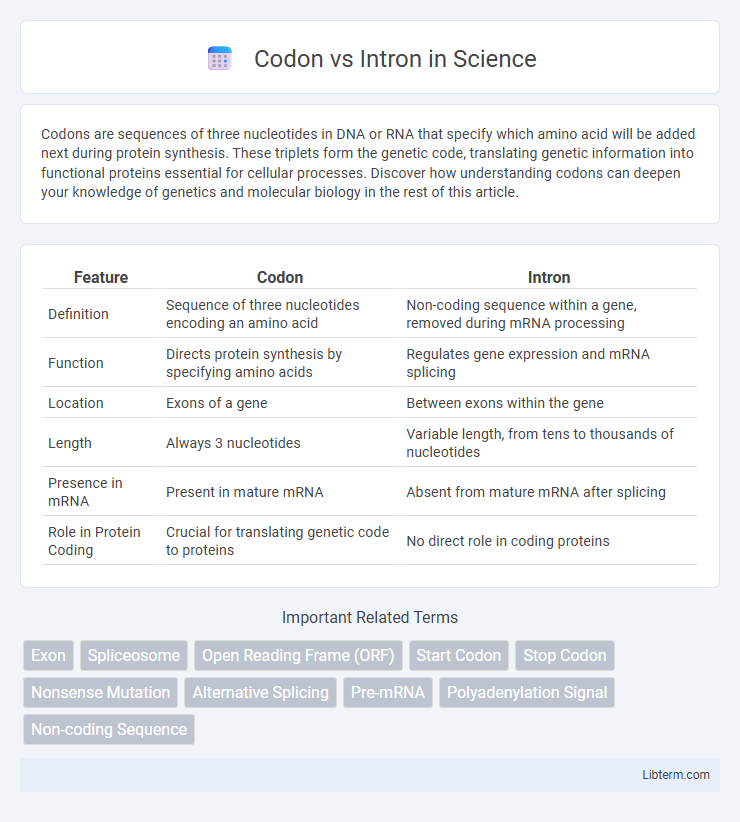Codons are sequences of three nucleotides in DNA or RNA that specify which amino acid will be added next during protein synthesis. These triplets form the genetic code, translating genetic information into functional proteins essential for cellular processes. Discover how understanding codons can deepen your knowledge of genetics and molecular biology in the rest of this article.
Table of Comparison
| Feature | Codon | Intron |
|---|---|---|
| Definition | Sequence of three nucleotides encoding an amino acid | Non-coding sequence within a gene, removed during mRNA processing |
| Function | Directs protein synthesis by specifying amino acids | Regulates gene expression and mRNA splicing |
| Location | Exons of a gene | Between exons within the gene |
| Length | Always 3 nucleotides | Variable length, from tens to thousands of nucleotides |
| Presence in mRNA | Present in mature mRNA | Absent from mature mRNA after splicing |
| Role in Protein Coding | Crucial for translating genetic code to proteins | No direct role in coding proteins |
Introduction to Codons and Introns
Codons are sequences of three nucleotides in mRNA that specify which amino acid will be added during protein synthesis, playing a crucial role in genetic code translation. Introns are non-coding sequences found within a gene's DNA or RNA transcript that are removed during RNA splicing, preventing them from coding for proteins. Understanding codons and introns is essential for interpreting gene expression and the regulation of protein production.
Defining Codons: The Basics of Genetic Coding
Codons are triplets of nucleotides in messenger RNA (mRNA) that specify particular amino acids during protein synthesis, serving as the fundamental units of the genetic code. Each codon corresponds to either one amino acid or a stop signal, enabling the ribosome to translate genetic information accurately into polypeptide chains. Unlike introns, which are non-coding sequences removed during RNA splicing, codons represent the essential coding regions that dictate the primary structure of proteins.
Understanding Introns: Non-Coding DNA Segments
Introns are non-coding DNA segments within genes that do not code for proteins but play critical roles in gene expression regulation and mRNA processing. Unlike codons, which are triplet sequences in exons that specify amino acids during translation, introns are removed through RNA splicing to produce mature mRNA. Understanding the difference between codons and introns is essential for insights into genetic mechanisms and molecular biology.
Codon Structure and Function in Protein Synthesis
Codons are sequences of three nucleotides in mRNA that specify particular amino acids during protein synthesis, forming the genetic code essential for translating genetic information into functional proteins. Each codon corresponds to a specific amino acid or a stop signal, enabling precise assembly of polypeptide chains by ribosomes. In contrast, introns are non-coding segments within pre-mRNA that are removed during RNA splicing, playing no direct role in the codon-based translation process.
Intron Roles in Gene Expression and Regulation
Introns play a critical role in gene expression by facilitating alternative splicing, which increases protein diversity without increasing the number of genes. These non-coding sequences regulate mRNA export, stability, and translation efficiency, impacting cellular function and development. Unlike codons, which specify amino acids during protein synthesis, introns modulate gene regulation at multiple post-transcriptional stages.
Key Differences Between Codons and Introns
Codons are sequences of three nucleotides in mRNA that specify amino acids during protein synthesis, forming the genetic code's fundamental units. Introns are non-coding regions within a gene's DNA that are transcribed into pre-mRNA but removed during RNA splicing before translation. The key difference lies in their roles: codons directly determine protein sequences, while introns regulate gene expression and mRNA processing without coding for proteins.
Biological Significance of Codons and Introns
Codons are sequences of three nucleotides in mRNA that specify amino acids during protein synthesis, playing a critical role in translating genetic information into functional proteins. Introns are non-coding regions within genes that are removed during RNA splicing, contributing to gene expression regulation and enabling alternative splicing to generate protein diversity. Both codons and introns are essential for maintaining genetic accuracy and enhancing cellular adaptability through precise protein production and regulation.
Evolutionary Perspectives: Codon and Intron Development
Codons, sequences of three nucleotides, play a crucial role in the translation of genetic information into proteins, reflecting evolutionary pressures for efficient and accurate protein synthesis. Introns, non-coding segments within genes, contribute to genetic diversity and regulatory complexity, evolving through mechanisms such as intron gain and loss that shape genome architecture. The co-evolution of codons and introns illustrates adaptive strategies in eukaryotic genomes, balancing coding precision with regulatory flexibility.
Common Misconceptions About Codons and Introns
Codons, sequences of three nucleotides, directly code for amino acids during protein synthesis, while introns are non-coding regions removed during mRNA processing. A common misconception is that introns influence protein sequences, but they are spliced out and do not translate into proteins. Another misunderstanding is that all codons are equally important; however, start and stop codons play critical regulatory roles in translation initiation and termination.
Future Research Directions in Codon and Intron Studies
Future research in codon and intron studies will focus on the role of codon usage bias in gene expression regulation and its impact on protein folding and function across diverse organisms. Advances in high-throughput sequencing and CRISPR-based genome editing will enable precise manipulation to uncover intron-mediated enhancement mechanisms and alternative splicing patterns influencing cellular differentiation and disease states. Integrative multi-omics approaches combining transcriptomics, epigenetics, and proteomics datasets will accelerate the discovery of novel codon-intron interactions and their evolutionary significance in adaptation and genome complexity.
Codon Infographic

 libterm.com
libterm.com